Beagles, with their adorable floppy ears and expressive eyes, have won the hearts of many dog owners. However, beneath their cute exterior lies a curious and energetic nature that can prove challenging for inexperienced handlers. The key to a well-behaved and obedient Beagle lies in proper training, which not only strengthens the bond between you and your furry companion but also ensures a harmonious life together.

Ready to embark on a journey to transform your Beagle into a well-mannered pet? Let’s dive into the world of how to train a Beagle, from understanding their behavior to mastering advanced techniques and avoiding common pitfalls.
Key Takeaways
- Understanding Beagle behavior is key to successful training.
- Positive reinforcement, crate training and socializing with other dogs and people are essential for teaching basic commands.
- Advanced techniques such as leash walking, games, avoiding mistakes & providing mental stimulation will help maintain progress longterm.
Find out how to train your beagle to be the well-behaved pup you desire – Read Free Report
Understanding Beagle Behavior: Why Proper Training is Key for These Energetic Dogs
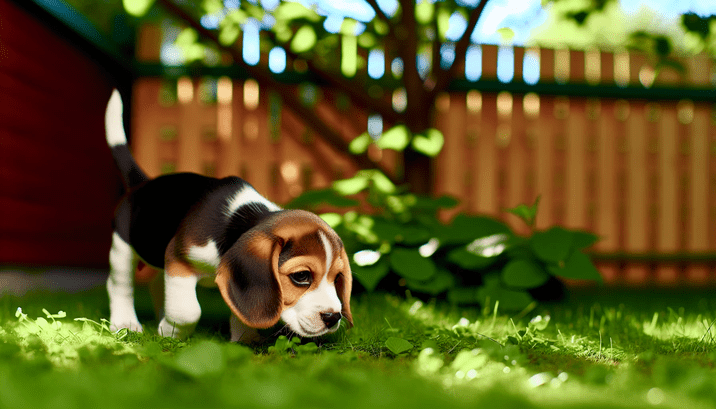
Image created with AI
Grasping a Beagle’s behavior is necessary for productive training. Their curious nature, strong scent-tracking abilities, and tendency towards disobedience underscore the importance of diligent training for Beagle owners. As a beagle owner, understanding these traits is crucial for a harmonious relationship with your furry friend and other dog owners.
Fostering a strong bond with your Beagle is key to their development and can be accomplished through activities like:
- Start teaching them to follow a scent trail to find a favorite toy
- Engaging in interactive play sessions
- Providing mental stimulation through puzzle toys and games
By understanding and addressing their specific needs, you can ensure a happy and well-behaved Beagle.
To prevent your energetic beagles from running away, provide them with an ultra-tasty treat (such as cheese or liver cake) that they will come to you for, and practice recall training multiple times a day. Crate training is also significant for Beagle puppies, as it offers a secure environment and assists in housebreaking.
#1 – Setting the Foundation: Early Training Strategies for Your Beagle Puppy
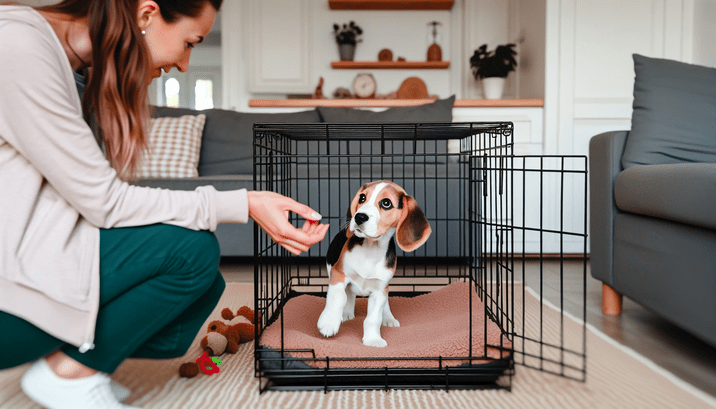
Image created with AI
Starting to train your Beagle pup immediately after you bring them home is of utmost importance. The recommended training approach for Beagles is positive reinforcement-based training, emphasizing boundaries and consistency, which helps in teaching Beagle basic commands.
Early training strategies for Beagle puppies may involve positive reinforcement, establishing a potty routine, and crate training. Here, we will examine these fundamental training strategies more closely.
#2 – The Power of Positive Reinforcement
Positive reinforcement in dog training is based on the principles of animal learning, specifically operant conditioning. It involves providing something positive, such as treats, praise, or play, to reinforce desired behaviors in dogs. This increases the probability of the behavior being repeated in the future. Positive reinforcement fosters trust and rapport between the owner and their dog and is an effective approach for training Beagles.
Examples of positive reinforcement techniques for Beagle training may include:
- Providing treats or praise as rewards for completed tasks
- Rewarding desirable behavior with treats or praise
- Utilizing positive reinforcement to teach new behaviors or modify existing health exercise habits.
#3 – Establishing a Potty Routine
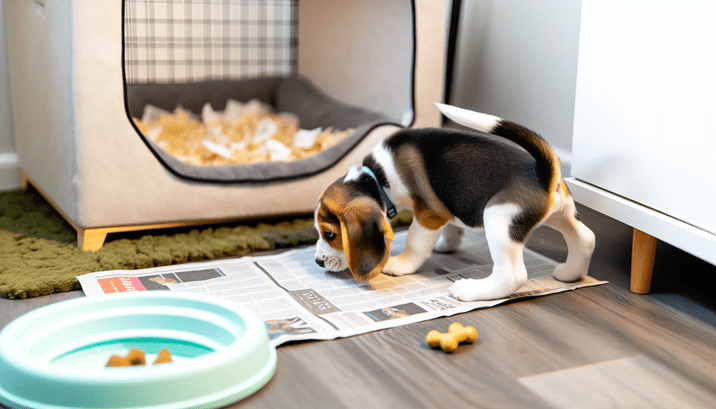
Image created with AI
House training Beagle puppies is imperative to prevent indoor accidents and foster positive habits. It is suggested to withhold food and water from a Beagle puppy three to four hours before bedtime during potty training. Take your Beagle puppy out frequently, for instance, every hour, during potty training.
To establish a consistent potty schedule for a Beagle puppy, take them out frequently, reward them for going outside, and create a routine.
#4 – Crate Training Basics
Crate training provides a safe space for your Beagle and aids in toilet training. It is recommended to start crate training a Beagle as soon as they are brought home as a puppy, as early crate training is highly encouraged.
A 36-inch crate is generally considered an appropriate size for an adult Beagle, while a small to medium crate is likely the best option for Beagle puppies.
#5 – Teaching Basic Commands to Your Beagle
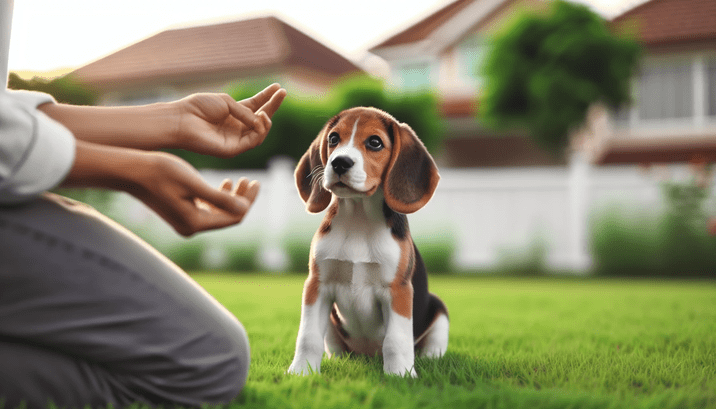
Image created with AI
Imparting basic commands to your Beagle, like sit, stay, and come, is necessary to enhance communication and obedience. To foster understanding of what is expected of them and to preempt undesirable behavior, it is important to instill boundaries in Beagles. Correcting a breach of boundaries is best achieved by offering praise when the Beagle redirects their actions.
By the time a Beagle puppy reaches their first birthday, they should be familiar with basic commands and have a daily routine established in their beagle puppy home.
#6 – Socializing Your Beagle with Other Dogs and People
One of the best beagle dog training tips is exposing your Beagle to other dogs and people can assist in fostering good manners and preventing aggression or fearfulness. The AKC S.T.A.R. Puppy program is an initiative that provides puppies with the opportunity to learn manners and socialize with others through training classes. It is recommended that the puppy learn socialization skills between eight and 16 weeks of age.
In the first week, it is important to ensure the puppy is familiar with their new environment and to begin socialization exercises.
Advanced Beagle Training Techniques
After your Beagle has mastered the basics, it’s time to proceed to advanced training techniques. In this section, we will explore mastering leash walking and utilizing games to teach commands, which can further enhance your Beagle’s skills and obedience.
For help to transform your beagle into a well-trained and happy companion today, check out our free beagle training report here.
#7 – Mastering the Leash: Enjoyable Walks with Your Beagle
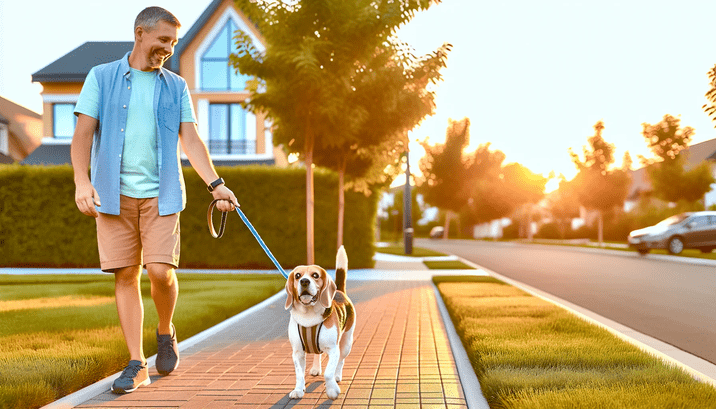
Image created with AI
Correct leash handling and preventing pulling are necessary for pleasant walks with a Beagle. To train a Beagle for leash walking without pulling or straining, follow these steps:
- Utilize positive reinforcement.
- Start training in a quiet area with minimal distractions.
- Instruct the ‘good’ command.
- Maintain your Beagle’s focus.
- Practice standing still or walking in a small circle until they learn to walk calmly beside you.
Remember, consistency and patience are essential when training your Beagle for leash walking. Want to uncover more fun beagle facts? Dive into the fascinating realm of these charming dogs and discover their unique traits and endearing behaviors.
#8 – Playful Learning: Using Games to Teach Commands
Including games in your Beagle’s training can render learning enjoyable and captivating. Games can promote a Beagle’s learning and command response by offering mental stimulation and reinforcing desirable behaviors. Engaging in games with your Beagle can facilitate the development of a strong connection and make training more pleasurable for both of you.
Examples of games that can be employed to teach commands to Beagles include:
- Fetch
- Hide and Seek
- Agility
- The Name Game
- The Shadow Game
- Give
- Hide and Seek
Training games should be utilized to socialize beagles regularly, at least a couple of times a day.
4 Common Mistakes for Beagle Owners to Avoid
When training a Beagle, you should be mindful of common mistakes like inconsistency, impatience, and the use of negative reinforcement. Irregular training may lead to difficulty in learning commands, confusion and frustration, as well as inconsistent behavior and a lack of discipline.
Impatience can make it difficult for Beagles to concentrate and learn, discourage them from training, and impede progress in the training process. Using negative reinforcement can cause Beagles to become stressed and tense, and they may not respond well to this type of training.
Mistake #1 – No Long-Term Training Goals for Your Beagle
Keeping up progress and managing any setbacks are part of the long-term training objectives for a Beagle. To establish long-term training goals for Beagles, consider:
- Socializing them with other dogs and people during the growth stage (between 8-16 weeks)
- Building confidence in the Beagle through training
- Creating a training plan with specific goals and milestones
- Evaluating and adjusting goals as needed based on your Beagle’s progress and behavior.
It is essential to be patient and consistent in your training efforts.
Mistake #2 – Not Addressing Troublesome Behaviors When Your Beagle Resists Training
Beagles might show resistance to training because of their stubborn nature and independent spirit. To successfully train them, it is important to be patient, persistent, and to use consistent training techniques. Positive reinforcement techniques, such as providing treats, praise, or play, have been successful for Beagles exhibiting troublesome behavior.
Identifying the cause of troublesome behavior in resisting Beagles, such as:
- Boredom
- Fear
- Separation anxiety
- The need for attention
Can prove beneficial in training them by enabling the addressing of the root cause.
Mistake #3 – Not Being Prepared With Essential Supplies for Effective Training
A treat pouch, harness, leash, collar, ID tags, cozy mat, treats, chews, and chew toys are all necessary for effective Beagle training. The quality of sleep a puppy receives will have a direct impact on their mood and motivation to learn, making a comfortable mat a valuable addition to your Beagle’s training toolkit.
It is recommended to use a leash of approximately 2m in length. Harnesses are preferable to collars when introducing leash training to a Beagle to avoid potential neck injury.
Mistake #4 – Not Transitioning to Adult Beagle Training After Their Puppy Years
When training a Beagle puppy, socialization skills and house training are imperative, whereas training an adult Beagle might demand less effort as they could already be house-trained and have a grasp of basic commands. As Beagles mature from puppyhood to adulthood, their behavior tends to become more consistent and predictable, and they tend to be less hyperactive and more tranquil and settled.
To accommodate your Beagle’s maturation, you may consider employing food rewards and playtime, maintaining positive reinforcement, selecting an appropriate training area, keeping your Beagle leashed, and recognizing their high energy levels. To ensure consistency in training while transitioning your Beagle from puppyhood to adulthood, remain consistent with your approach and training methods, utilize positive reinforcement to encourage desired behaviors, establish consistent routines and expectations for your Beagle, regularly practice and reinforce training exercises, provide physical enrichment and exercise to maintain your Beagle’s health and fitness, employ positive words and encouragement during training sessions, and refrain from yelling or punishment, as it can impede the training process.
Summary
In conclusion, training your Beagle is an essential aspect of responsible dog ownership that fosters a strong bond between you and your furry companion, ensuring a harmonious life together. From understanding Beagle behavior and early training strategies to mastering advanced techniques and avoiding common mistakes, this guide has provided you with the knowledge and tools necessary to transform your Beagle into a well-mannered and obedient pet. Remember, patience, consistency, and positive reinforcement are the keys to successful Beagle training. So, keep up the good work, and enjoy the journey with your intelligent and loving Beagle by your side.
Frequently Asked Questions
How to train beagles?
Start early and be sure to establish a schedule when training a Beagle. Keep commands simple and positive, and explore cage training to reduce barking. Socializing your pet will also help them become more comfortable in different situations.
Are beagles easy to train?
Beagles may be more difficult to train than other breeds, making them a challenge for first-time dog owners.
At what age should I start training my Beagle puppy?
It is recommended to begin training your Beagle puppy upon bringing them home, at 8 weeks of age.
What are some effective positive reinforcement techniques for Beagle training?
Positive reinforcement is a powerful tool for Beagle training, such as giving treats or praise when tasks are completed, rewarding good behaviors with treats or praise, and reinforcing new or existing habits.
How can I establish a consistent potty routine for my Beagle puppy?
Establish a consistent potty routine for your Beagle puppy by taking them out frequently, rewarding them when they go outside, and creating an everyday schedule.
Learn how to train your beagle to be the well-behaved dog you desire –> Access our Free Report
Shop for beagle-themed products and gifts that beagle enthusiasts will love.
